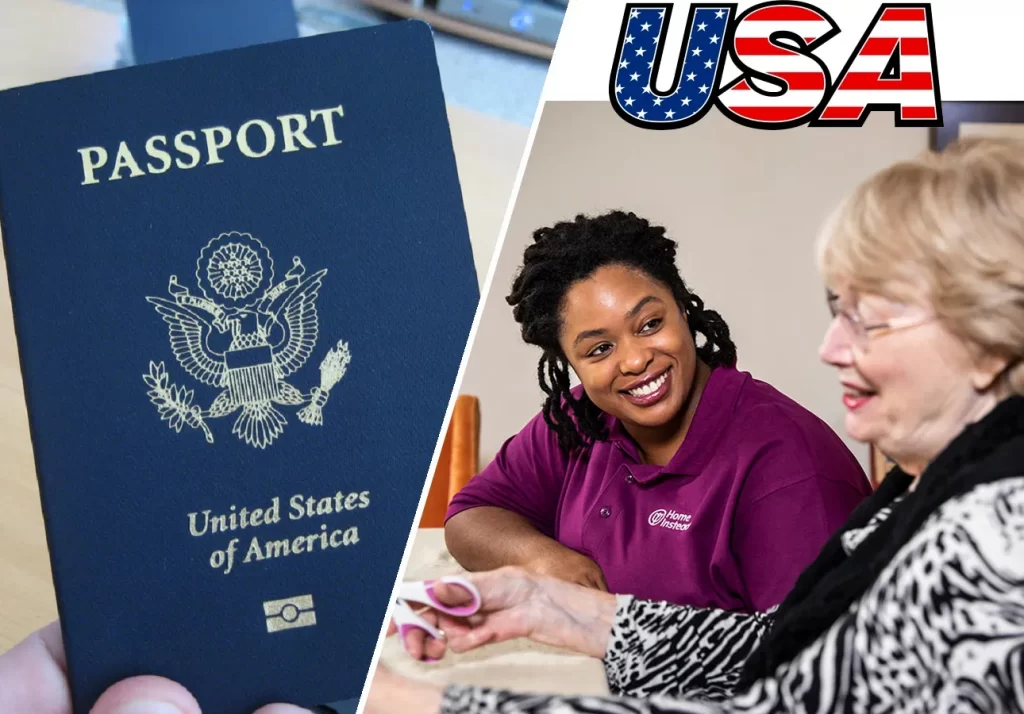When I first started exploring caregiving opportunities in the U.S., I was overwhelmed by the number of options. However, one thing stood out: visa sponsorship caregiver jobs offer an incredible pathway for international professionals like us to live, work, and thrive in the United States. With an aging population and a rising caregiver demand, the U.S. Bureau of Labour Statistics projects a staggering 25% growth in caregiving jobs between 2021 and 2031. That’s why understanding these roles and how they can pave the way for a brighter future is essential. Whether you’re a seasoned professional or just starting out, this guide will take you through the top 10 visa sponsorship caregiver jobs in the USA and how to secure one.
What are Visa Sponsorship Caregiver Jobs?
Visa sponsorship caregiver jobs are employment opportunities in the U.S. where an employer sponsors an international worker for a work visa, allowing them to live and work legally in the country. These roles are in high demand due to the increasing elderly population and the growing need for in-home healthcare services.
Why Are Caregivers in High Demand?
- Aging Population: According to the U.S. Census Bureau, the number of Americans aged 65 and older is projected to reach 80 million by 2040.
- Healthcare Workforce Shortages: The Bureau of Labor Statistics reports that caregiver jobs will grow by 25% from 2021 to 2031, much faster than the average for all occupations.
- Increase in Home Healthcare Needs: More seniors prefer aging in place, leading to higher demand for home-based caregiving services.
Who Typically Offers Visa Sponsorship?
- Home healthcare agencies
- Nursing homes and assisted living facilities
- Hospitals and rehabilitation centers
- Private families seeking live-in caregivers
Types of Caregiver Roles with Visa Sponsorship
#1. Home Health Aides (HHA)
Responsibilities:
- Provide basic medical care under a nurse’s supervision.
- Assist with mobility, bathing, and dressing.
- Monitor vital signs and medication reminders.
Visa Type: H-2B Visa (Temporary Work Visa)
Who They Work For: Home healthcare agencies, private clients
#2. Personal Care Aides (PCA)
Responsibilities:
- Help with meal preparation, light housekeeping, and errands.
- Offer companionship and emotional support.
- Assist with personal hygiene tasks.
Visa Type: H-2B or EB-3 Visa (for skilled/unskilled workers)
Who They Work For: Assisted living facilities, home care agencies
#3. Certified Nursing Assistants (CNA)
Responsibilities:
- Work under licensed nurses in hospitals, nursing homes, and clinics.
- Assist patients with daily activities like bathing, feeding, and toileting.
- Record and monitor patient progress.
Visa Type: EB-3 Visa (Permanent Residency Pathway)
Who They Work For: Hospitals, long-term care facilities, rehabilitation centers
#4. Live-In Caregivers
Responsibilities:
- Provide 24/7 care and supervision to elderly or disabled individuals.
- Handle medication management, meal preparation, and mobility assistance.
- Perform light housekeeping and maintain a safe environment for the client.
Visa Type: EB-3 or J-1 Visa (Exchange Visitor Program)
Who They Work For: Private families, home health agencies
How Visa Sponsorship Works for Caregivers
- Employer Sponsorship: A U.S.-based employer petitions for the caregiver’s work visa.
- Visa Processing: The employer assists in completing immigration paperwork.
- Work Authorization: Upon visa approval, the caregiver can legally work in the U.S.
Top 10 Visa Sponsorship Caregiver Jobs in the USA
#1. Home Instead Senior Care
- Role: In-home caregiver for seniors.
- Sponsorship Options: H-2B and EB-3 visas.
- Highlights:
- Competitive pay.
- Training programs for professional growth.
- Nationwide presence ensures diverse job locations.
#2. BrightStar Care
- Role: Personal care aides and certified nursing assistants (CNAs).
- Sponsorship Options: EB-3 visa for permanent residency.
- Highlights:
- Flexible schedules.
- Offers health insurance and retirement benefits.
#3. Visiting Angels
- Role: Live-in caregiver for seniors or individuals with disabilities.
- Sponsorship Options: H-2B visa for temporary roles.
- Highlights:
- Provides 24/7 support for caregivers.
- Great for those with prior caregiving experience.
#4. Right at Home
- Role: Companion care and personal care aide.
- Sponsorship Options: EB-3 and H-2B visas.
- Highlights:
- Focus on matching caregivers with compatible clients.
- Offers educational resources for skill improvement.
#5. Maxim Healthcare Services
- Role: CNAs and HHAs (Home Health Aides).
- Sponsorship Options: EB-3 visa for skilled professionals.
- Highlights:
- Nationwide coverage with opportunities in various states.
- Special programs for career advancement.
#6. Synergy HomeCare
- Role: In-home caregiver and respite care specialist.
- Sponsorship Options: H-2B visa for temporary workers.
- Highlights:
- Offers personalized care training.
- Opportunities for advancement into leadership roles.
#7. Comfort Keepers
- Role: Senior caregiver and live-in companion.
- Sponsorship Options: H-2B visa.
- Highlights:
- Provides tools and resources for caregivers.
- Focus on enhancing caregiver-client relationships.
#8. Amada Senior Care
- Role: Personal care aide and dementia care specialist.
- Sponsorship Options: EB-3 visa.
- Highlights:
- Known for excellent caregiver training.
- Opportunities in specialized care, like Alzheimer’s support.
#9. Interim HealthCare
- Role: Medical caregivers, CNAs, and hospice care workers.
- Sponsorship Options: EB-3 visa for skilled roles.
- Highlights:
- Offers both medical and non-medical roles.
- Strong focus on employee wellness and satisfaction.
#10. Care.com
- Role: Freelance caregiving jobs with visa sponsorship opportunities through employers.
- Sponsorship Options: Depends on individual employer arrangements.
- Highlights:
- Flexible freelance options.
- Access to a large network of caregiving opportunities.
Visa Options for Sponsored Caregivers in the USA
Caregivers seeking visa sponsorship in the U.S. have multiple options depending on their qualifications, work duration, and employer. Below is a breakdown of the most common caregiver visa options, including requirements, benefits, and application processes.
#1. H-2B Visa: Temporary Work Visa for Caregivers
The H-2B visa is a non-immigrant work visa that allows U.S. employers to hire foreign workers for temporary non-agricultural jobs, including caregiving.
Key Features:
✅ Designed for temporary caregiving roles, such as live-in home aides or seasonal caregiving work.
✅ Valid for up to one year but can be renewed twice for a total of three years.
✅ Requires a U.S. employer sponsorship—the employer must prove a shortage of local workers.
Requirements:
- Must have a valid job offer from a U.S. employer.
- The employer must apply for Temporary Labor Certification from the U.S. Department of Labor (DOL).
- Proof of caregiver experience is usually required, but no specific education level is mandatory.
Best For:
- Caregivers looking for short-term employment in home health or assisted living facilities.
- Candidates without nursing qualifications but with prior caregiving experience.
Limitations:
❌ No path to permanent residency—must leave the U.S. when the visa expires.
❌ Visa cap restrictions—only 66,000 H-2B visas are issued per year, so competition is high.
#2. EB-3 Visa: Permanent Residency for Caregivers
The EB-3 visa is an employment-based immigrant visa for skilled, professional, and unskilled workers. Caregivers generally fall under the unskilled worker (EW-3) category, allowing them to apply for U.S. green cards (permanent residency).
Key Features:
✅ Provides a direct path to a U.S. green card for caregivers.
✅ Allows spouses and children (under 21) to apply for dependent visas (EB-3 derivative status).
✅ No strict education requirements, but caregiving certifications like CNA or HHA improve chances.
Requirements:
- A U.S. employer sponsorship is required.
- The employer must file a PERM labor certification proving there are no U.S. workers available for the role.
- The caregiver must have some work experience in a caregiving or healthcare-related role.
Best For:
- Caregivers looking for long-term employment in nursing homes, assisted living facilities, or private households.
- Candidates wanting permanent U.S. residency and a clear path to citizenship.
Limitations:
❌ Processing can take 12–36 months due to visa backlogs.
❌ Employers must cover visa sponsorship costs, which limits the number of available sponsors.
#3. J-1 Visa: Cultural Exchange Visa for Caregivers & Au Pairs
The J-1 visa is a non-immigrant visa for individuals participating in cultural exchange programs, including caregivers, home health aides, and au pairs.
Key Features:
✅ Allows foreign caregivers to work in the U.S. as part of an approved exchange program.
✅ Valid for 12–24 months with the possibility of extension (up to five years in some cases).
✅ Employers provide training, housing, and financial support in many cases.
Requirements:
- Must apply through a U.S. Department of State-approved sponsor (e.g., Cultural Care Au Pair).
- High school diploma and at least 200 hours of childcare experience are required.
- English proficiency test may be required.
Best For:
- Young caregivers (18–26 years old) who want to work as au pairs for U.S. families.
- Caregivers seeking short-term caregiving roles with cultural immersion opportunities.
Limitations:
❌ No direct path to permanent residency (must apply for a different visa after J-1 expiration).
❌ Caregivers must return to their home country for two years before applying for another U.S. visa (unless waived).
Which Visa is Best for You?
| Visa Type | Duration | Best For | Path to Green Card |
| H-2B Visa | 6 months – 3 years | Short-term caregivers | ❌ No |
| EB-3 Visa | Permanent | Long-term caregivers | ✅ Yes |
| J-1 Visa | 12 months – 5 years | Au pairs and cultural exchange caregivers | ❌ No |
Eligibility Requirements For Visa Sponsorship Caregiver Jobs in the US
Securing a visa-sponsored caregiver job in the U.S. requires meeting specific qualifications. Here’s a detailed breakdown:
#1. Experience Requirements
- While some entry-level positions exist, most employers prefer candidates with prior caregiving experience.
- Experience can be from formal employment in a hospital, nursing home, or assisted living facility or informal experience caring for elderly or disabled family members.
- Employers highly value compassionate, patient, and reliable caregivers.
#2. Required Certifications
- Certified Nursing Assistant (CNA): A CNA certification qualifies you for higher-paying caregiver roles and enhances visa sponsorship chances.
- Home Health Aide (HHA): Many employers require HHAs, especially for home-based care.
- CPR and First Aid Certification: This ensures you can handle emergencies and is often a mandatory requirement.
#3. Educational Requirements
- A high school diploma or equivalent is typically the minimum requirement.
- Some states may require additional training programs before employment.
#4. English Proficiency
- Fluency in English is essential to communicate effectively with patients, families, and medical professionals.
- Some employers may require candidates to take an English language proficiency test.
#5. Background Checks and Health Screenings
Employers often conduct criminal background checks to ensure caregiver reliability.
A medical screening or tuberculosis (TB) test may be required before employment.
How to Apply for Caregiver Jobs in the USA with Visa Sponsorship
Once you meet the qualifications, the next step is crafting a successful job application. Here’s how:
#1. Use Job Portals
To find caregiver jobs offering visa sponsorship, explore these platforms:
- Indeed (www.indeed.com) – Search for “visa sponsorship caregiver jobs.”
- Care.com (www.care.com) – Connects caregivers with families and healthcare facilities.
- SimplyHired (www.simplyhired.com) – Lists caregiving opportunities with sponsorship options.
- Glassdoor (www.glassdoor.com) – Provides company insights and salary details.
- MyCNAJobs (www.mycnajobs.com) – Specifically for CNAs and HHAs.
💡 Pro Tip: Set job alerts on these platforms to receive updates on new visa sponsorship job postings.
#2. Create a Standout Application
A strong application significantly improves your chances of landing an interview. Follow these tips:
✅ Resume Writing:
- Clearly list previous caregiving roles and years of experience.
- Highlight certifications like CNA, HHA, and First Aid.
- Emphasize soft skills such as patience, empathy, communication, and time management.
- Mention experience handling seniors, dementia patients, or individuals with disabilities.
✅ Cover Letter:
- Personalize it for each job.
- Express why you’re passionate about caregiving.
- Explain why you’re interested in working in the U.S.
#3. Network for More Opportunities
- Leverage LinkedIn: Connect with recruiters and professionals in the healthcare industry.
- Join Caregiver Facebook Groups: Many job postings are shared in community groups.
- Attend Virtual Job Fairs: Some U.S. agencies recruit caregivers internationally.
Benefits of Working as a Caregiver in the USA
#1. Competitive Salaries and Financial Stability
- According to the U.S. Bureau of Labour Statistics (BLS, 2023), the median salary for caregivers (including home health aides and personal care aides) is $28,000–$35,000 per year.
- Experienced caregivers, especially those with CNA certification, can earn $40,000+ annually.
- Some live-in caregivers receive free housing, meals, and transportation in addition to their salary.
#2. Job Security and High Demand
- The demand for caregivers is skyrocketing due to an aging population—by 2030, 1 in 5 Americans will be 65 or older (U.S. Census Bureau).
- The caregiving industry is projected to grow by 25% from 2021–2031, making it one of the fastest-growing job sectors in the U.S. (BLS, 2023).
#3. Career Growth and Professional Development
- Caregivers can advance into higher-paying roles with additional training:
✅ Certified Nursing Assistant (CNA) – $35,000–$45,000 annually
✅ Licensed Practical Nurse (LPN) – $48,000–$58,000 annually
✅ Registered Nurse (RN) – $75,000–$90,000 annually - Many healthcare facilities offer tuition reimbursement, allowing caregivers to study while working.
#4. Immigration Pathways to U.S. Permanent Residency
- Caregivers on EB-3 visas can obtain a green card (permanent residency), making it possible to bring family members to the U.S.
- Some employers offer sponsorship for continued education, which can help transition into other medical careers.
#5. Personal Fulfillment and Making a Difference
- Caregiving is one of the most rewarding careers, as it allows you to help vulnerable individuals improve their quality of life.
- Many caregivers develop strong emotional bonds with their patients, creating a meaningful impact every day.
Challenges of Working as a Caregiver in the USA (and How to Overcome Them)
#1. Cultural Adjustment and Workplace Expectations
✅ Challenge: Adapting to U.S. workplace culture, which values punctuality, professionalism, and patient-centered care.
✅ Solution:
- Research U.S. caregiving norms—understand patient rights, privacy laws, and ethical care practices.
- Join caregiver support groups to connect with others who have been through similar experiences.
#2. Certification and Licensing Requirements
✅ Challenge: U.S. caregiving jobs often require certifications like CNA (Certified Nursing Assistant) or HHA (Home Health Aide).
✅ Solution:
- Take online certification courses before arriving in the U.S.
- Many employers offer paid training or help caregivers obtain necessary credentials.
#3. Physically and Emotionally Demanding Work
✅ Challenge: Caregiving involves long hours, heavy lifting, and emotional stress from caring for ill or elderly patients.
✅ Solution:
- Learn proper body mechanics to avoid injuries when assisting patients.
- Prioritize self-care—schedule breaks, maintain a balanced diet, and get enough sleep.
#4. Workload and Long Hours
✅ Challenge: Many caregivers work 12-hour shifts or live-in caregiving roles, which can be exhausting.
✅ Solution:
- Time management is key—use apps to organize daily tasks efficiently.
- Set realistic boundaries to avoid burnout and communicate with your employer about scheduling needs.
#5. Language and Communication Barriers
✅ Challenge: Some international caregivers struggle with English proficiency, making it difficult to communicate with patients and healthcare staff.
✅ Solution:
- Enroll in English as a Second Language (ESL) courses before or after arriving in the U.S.
- Use translation apps like Google Translate to assist with communication in real-time.
FAQs About Caregiver Jobs in the USA
What is the average processing time for a caregiver visa?
Visa processing times vary:
- H-2B visa: 2–6 months.
- EB-3 visa: 12–18 months.
Can I bring my family with me?
Some visas, like the EB-3, allow dependents to join you in the U.S.
Key Takeaways
- Caregiver jobs with visa sponsorship are in high demand due to the U.S.’s aging population.
- Employers like BrightStar Care and Visiting Angels provide excellent benefits and training.
- Visa options include H-2B, EB-3, and J-1 visas.
- Using job portals and networking can significantly improve your chances of landing a job.
- A well-prepared application is crucial—use a template to ensure professionalism.
Conclusion
Caregiver jobs in the U.S. offer not just a chance to advance your career but also an opportunity to impact lives meaningfully. With the right preparation and resources, this path can lead to both personal and professional growth. Are you ready to take the first step toward a rewarding caregiving career in the U.S.?
Related Articles
- Can Immigration Sponsorship Be Revoked? What Immigrants and Sponsors Need to Know
- Mathematics Teaching Jobs in the USA with Visa Sponsorship: A Complete Guide
- How to Get Elderly Care Jobs in the USA with Visa Sponsorship: A Step-by-Step Guide
- How to Apply for a Holland Visa from Nigeria: A Step-by-Step Guide
- Australia Admission for International Students



